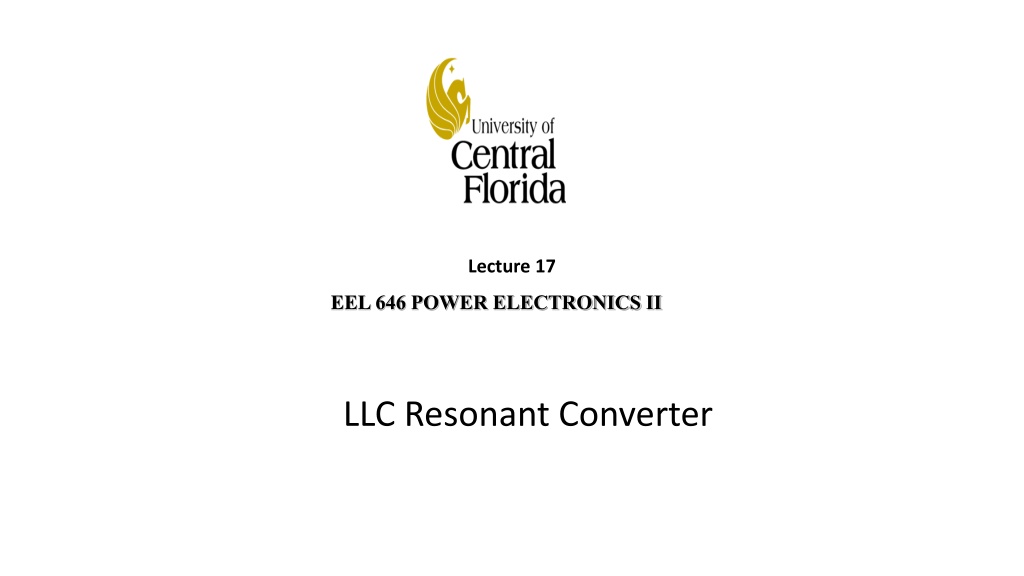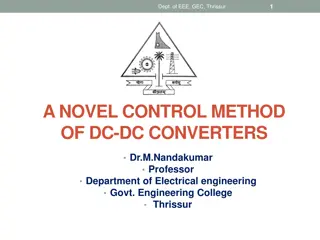
Understanding LLC Resonant Converter Operation and Analysis
Explore the operational principles of LLC resonant converters, including the features of the LLC tank, different modes of operation at, below, and above resonance, and the fundamental harmonic approximation analysis used to simplify circuit complexities in power electronics.
Download Presentation

Please find below an Image/Link to download the presentation.
The content on the website is provided AS IS for your information and personal use only. It may not be sold, licensed, or shared on other websites without obtaining consent from the author. Download presentation by click this link. If you encounter any issues during the download, it is possible that the publisher has removed the file from their server.
E N D
Presentation Transcript
Lecture 17 EEL 646 POWER ELECTRONICS II LLC Resonant Converter
Agenda Carry out approximated LLC Resonant Converter
Introduction Introduction Transformer and rectifier: Transformer provides galvanic isolation Rectifier transforms the pulsating voltage to DC Switching Bridge: Generate pulsating voltage Either a half-bridge (with 0.5 gain) or full-bridge ( with unity gain) Resonant tank: Modulates the gain through changing the switching frequency
LLC Tank LLC Tank Features: Soft switching for wide range high gain Low power density High efficiency Modes of Operation: At resonance: Gain = 1 Below resonance: Gain > 1 Above resonance: Gain < 1
At Resonance At Resonance The switching freq. operates at resonant freq. 1 ??= ??= 2? ???? ?? is clamped to the load through the whole cycle ???is a pure sine wave Complete power delivery to the rectifier
Below Resonance Below Resonance ??< ?? Power delivery period ends at ??/2 As ???= ???, ?? resonates with the tank forming a freewheeling period The converter operates in this mode when a boost operation is required
Above Resonance Above Resonance ??> ?? ??? is interrupted by the end of the half cycle before completion ZCS is lost in the rectifying diodes The converter operates in this mode when a buck operation is required
Approximation Analysis Approximation Analysis Fundamental Harmonic Approach
??(?) ?? ? ?? 0.5?? ??
Fundamental Harmonic Approximation (FHA) Fundamental Harmonic Approximation (FHA) Commonly used to overcome the non- linear circuit complexity Considering only first harmonics results in pure input and output sinusoidal voltage and current. The DC Gain K can be defined as ? = ??2 ??? ??? ???+ ??? ? =???? = (???) 1+???+??? ??? ??? ???+ ??? ?2(?? 8 ??=?? ??2(? 1) ??)2?? ???= ? ?,?,?? = ? = ?? ???2 1 + ??2??2 12? 1 ?2 ? =??+ ?? = 1 +?? ?? ?? ?? ??? ??/?? ??? ? = =
Consider the output circuit for an LLC converter Consider the output circuit for an LLC converter whose square input voltage is shown in (a) whose square input voltage is shown in (a) ??(?) = ??? ?? + ? ??(?) ??(?)
Consider the output circuit for an LLC converter Consider the output circuit for an LLC converter whose square input voltage is shown in (a) whose square input voltage is shown in (a) ?? ??? ??(?) =
Gain Characteristics Gain Characteristics ?? ?? = 5
Design Example: Design Example: Design the LLC DC Design the LLC DC- -DC Converter DC Converter
Design Steps Design Steps 1. Calculating Transformer turns ratio and the min. and max. gains Assume the gain at the nominal input voltage is unity. The maximum and minimum gains: ????=???,??? ????=33 ? ???? ???,??? ? =?? 181 = 1.83 ????= ???,??? ?? ????=???,??? ????=33 Transformer ratio: 361 = 0.92 ???,??? ???,??? ???? = 133 ? = ???? 400= 0.0825 ?? ?? 1 = 0.0825= 12.12
Design Steps Design Steps 2. Let us assume the ratio of the magnetizing and resonant inductor are 5, i.e. ? = 1 +?? ?? ?? = 6 = 5 ??
Design Steps Design Steps 3. Selecting ???? that guarantee inductive operation for the max. gain required. ????= 0.4
Gain Characteristics Gain Characteristics ?? ?? = 5
Design Steps (continue) Design Steps (continue) 3. Finding the min. switching frequency (??_???) from the first derivative of the gain equation 4. Verifying the voltage gain by determining the max. gain (????) at min. input voltage (????)
Design Steps (Gain Verification) Design Steps (Gain Verification)
Design Steps (continue) Design Steps (continue) 5. Finally, calculating the resonant components values
Simulation Results Simulation Results ???= 33? ??= 220? ???= 36? ??= 250? ???= 25? ??= 160?






















